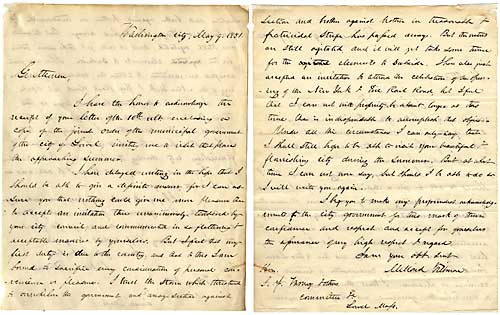Sold – President Shows His Motivation For Supporting the Compromise of 1850

“I trust that the storm which threatened to overwhelm the government...has passed away.”.
The annexation of Texas to the United States and the gain of immense new lands at the close of the Mexican War in 1848 brought to a flaming pitch the hostility between North and South concerning the extension of slavery into the territories. The subject had immediacy because with the huge number...
The annexation of Texas to the United States and the gain of immense new lands at the close of the Mexican War in 1848 brought to a flaming pitch the hostility between North and South concerning the extension of slavery into the territories. The subject had immediacy because with the huge number of people who were flooding into California seeking gold, that territory was already seeking statehood. President Taylor, a Louisiana slaveholder, felt that slavery was inappropriate for the west. He supported organizing all the former Mexican lands into two territories – California and New Mexico – and bringing them into the Union as free states. With only two new states, the balance between slave and free states in Congress would scarcely be disturbed. This potential loss to slavery met with violent Southern opposition, with the South demanding guarantees of equal position in the territories, as well as the execution of fugitive slave laws. There were threats that unless the Southern states were mollified, they would withdraw from the Union altogether.
To reconcile the opposing sides, in March 1850, Henry Clay proposed that a series of measures be passed as an omnibus bill; these would come to be called the Compromise of 1850. The measures were the admission of California as a free state; the organization of New Mexico and Utah territories without mention of slavery, the status of that institution to be determined by the territories themselves when they were ready to be admitted as states; the prohibition of the slave trade in the District of Columbia; a more stringent fugitive slave law; and the settlement of Texas boundary claims at federal expense. President Taylor opposed the compromise bills and stated that he would veto them. Then fate intervened and Taylor died in July. Fillmore, his successor, supported the Compromise which was signed into law in September 1850.
The new president indicates here that he feared a civil war was the alternative if the Compromise measures were not passed, and reveals his belief that his actions had prevented such a catastrophe. Despite these hopeful words, Fillmore’s urgent language and his perception of an ongoing need for his presence in Washington convey the mood of pervasive crisis in the capitol that continued even after passage of the measures, as the anger and controversy they engendered raged.
Autograph Letter Signed as president, two pages, Washington, May 9, 1851, to publisher S.J. Varney and his town committee of Lowell, Massachusetts, that had invited him to visit. "I have the honor to acknowledge the receipt of your letter of the 10th ult. enclosing a copy of the joint order of the municipal government of the city of Lowell, writing me to visit the place the approaching summer. I have delayed writing in the hope that I should be able to give a definite answer for I can assure you that nothing could give me more pleasure than to accept an invitation thus unanimously tendered by your city council and communicated in the flattering & acceptable manner by yourselves. But I feel that my first duty is due to the country; and that to this I am bound to sacrifice every consideration of personal convenience or pleasure. I trust that the storm which threatened to overwhelm the government and array section against section and brother against brother in treasonable & fratricidal strife, has passed away. But the waters are still agitated and it will yet take some time for the elements to subside. I have also just accepted an invitation to attend the celebration of the opening of the New York & Erie Rail Road, but I feel that I cannot with propriety be absent longer at this time than is indispensable to accomplish that object. Under all the circumstances I can only say that I shall still hope to be able to visit your beautiful & flourishing city during the summer. But at what time I cannot say…I beg you to make my profoundest acknowledgments to the city government for this mark of their confidence…"
Fillmore’s fear of civil war and the destruction of the U.S. government was strong enough for him to be willing to state it directly as his motivation for backing the Compromise of 1850 (he even adds emphasis by using the dramatic “brother against brother” allusion). History would soon prove he was right to be alarmed about the possibility of division and war. Alas, however, it would also reveal that he was wrong to think he had avoided it. From the Forbes Collection.

Frame, Display, Preserve
Each frame is custom constructed, using only proper museum archival materials. This includes:The finest frames, tailored to match the document you have chosen. These can period style, antiqued, gilded, wood, etc. Fabric mats, including silk and satin, as well as museum mat board with hand painted bevels. Attachment of the document to the matting to ensure its protection. This "hinging" is done according to archival standards. Protective "glass," or Tru Vue Optium Acrylic glazing, which is shatter resistant, 99% UV protective, and anti-reflective. You benefit from our decades of experience in designing and creating beautiful, compelling, and protective framed historical documents.
Learn more about our Framing Services







































































































